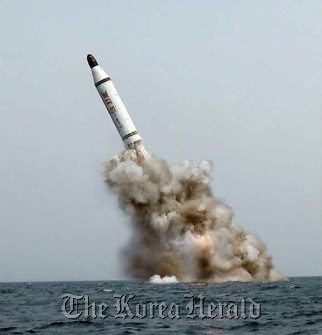North Korea appears to have failed to launch a ballistic missile from a submarine in yet another provocative action that may escalate tensions on the peninsula, government sources in Seoul said Sunday.
The communist state is believed to have tried to fire a KN-11 missile from a submarine in the East Sea between 2:20 p.m. and 2:40 p.m. Saturday, but it stopped short of soaring from the waters, the sources said.
Seoul’s Defense Ministry declined to officially confirm the report.
“The cover of the capsule where the missile was placed has been found,” one source said, requesting anonymity due to the sensitivity of the issue.
The communist state is believed to have tried to fire a KN-11 missile from a submarine in the East Sea between 2:20 p.m. and 2:40 p.m. Saturday, but it stopped short of soaring from the waters, the sources said.
Seoul’s Defense Ministry declined to officially confirm the report.
“The cover of the capsule where the missile was placed has been found,” one source said, requesting anonymity due to the sensitivity of the issue.

The discovery marks the first test of a submarine-launched ballistic missile since May, when Pyongyang claimed it had successfully ejected a “strategic submarine ballistic missile” from the waters while leader Kim Jong-un observed.
The test of a dummy projectile took place from a newly developed 2,000-ton Sinpo-class submarine at a shipyard in Sinpo, during which it is widely known to have flown about 150 meters. The North was likely to carry out the latest experiment at the same place, instead of using a ground SLBM launchpad believed to be incomplete.
Concerns had arisen in recent weeks that the Kim Jong-un regime may be counting down to a fresh rocket test after it set an extensive no-sail zone in the waters off its eastern coastal city of Wonsan, effective from Nov. 11 to Dec. 7.
Seoul forecasts that it will take at least two years for Pyongyang to be able to deploy a submarine carrying a ballistic missile, and Saturday’s perceived failure may demonstrate that it has yet to master the technology.
With ejection marking a crucial early stage in the SLBM development, the new test is deepening concerns as despite the failure it could help eventually secure a second-strike capability, boost the country’s nuclear deterrence and thus bring its threat to a new high. Missile launches from submerged vessels are more challenging to detect than land-based ones.
Pyongyang is believed to have conducted a series of ejection tests as part of its drive to secure the triad of delivery tools of a nuclear arsenal, consisting of strategic bombers, intercontinental ballistic missiles and SLBMs.
It is believed to operate some 70 submarines, about 20 of which are the 1,800-ton Romeo-class and about 40 of which are the 325-ton Sangeo-class vessels. Albeit old and equipped with outdated weapons, they outnumber South Korea’s fleet.
The findings came just a day before President Park Geun-hye departs for Paris for a U.N. climate change conference where she will gather with the leaders of more than 140 countries, including U.S. President Barack Obama and U.N. Secretary-General Ban Ki-moon, who has been seeking to visit Pyongyang.
Last Thursday, the two Koreas also agreed to hold high-level talks in the North’s western border city of Gaeseong on Dec. 11.
By Shin Hyon-hee (heeshin@heraldcorp.com)


![[AtoZ into Korean mind] Humor in Korea: Navigating the line between what's funny and not](http://res.heraldm.com/phpwas/restmb_idxmake.php?idx=644&simg=/content/image/2024/04/22/20240422050642_0.jpg&u=)
![[Exclusive] Korean military set to ban iPhones over 'security' concerns](http://res.heraldm.com/phpwas/restmb_idxmake.php?idx=644&simg=/content/image/2024/04/23/20240423050599_0.jpg&u=20240423183955)


![[Graphic News] 77% of young Koreans still financially dependent](http://res.heraldm.com/phpwas/restmb_idxmake.php?idx=644&simg=/content/image/2024/04/22/20240422050762_0.gif&u=)

![[Herald Interview] Why Toss invited hackers to penetrate its system](http://res.heraldm.com/phpwas/restmb_idxmake.php?idx=644&simg=/content/image/2024/04/22/20240422050569_0.jpg&u=20240422150649)





![[Exclusive] Korean military to ban iPhones over security issues](http://res.heraldm.com/phpwas/restmb_idxmake.php?idx=652&simg=/content/image/2024/04/23/20240423050599_0.jpg&u=20240423183955)



![[Today’s K-pop] Ateez confirms US tour details](http://res.heraldm.com/phpwas/restmb_idxmake.php?idx=642&simg=/content/image/2024/04/23/20240423050700_0.jpg&u=)